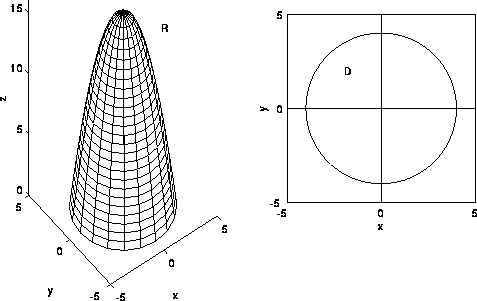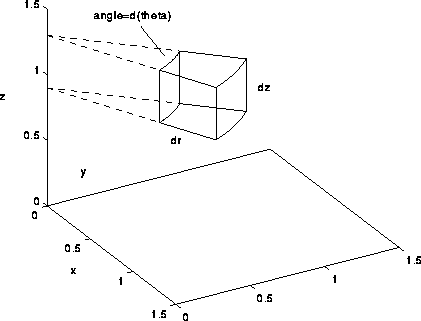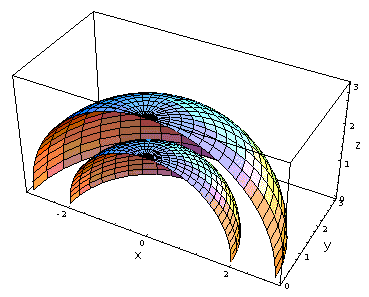
This page contains the following sections:
Triple Integrals in Cylindrical Coordinates
Cylindrical coordinates are obtained from Cartesian coordinates by replacing the x and y coordinates with polar coordinates r and theta and leaving the z coordinate unchanged.
It is simplest to get the ideas across with an example. Consider an object which is bounded above by the inverted paraboloid z=16-x^2-y^2 and below by the xy-plane. Suppose that the density of the object is given by f(x,y,z)=8+x+y. What is the mass of the object?

The object is shown above. The mass is given by the triple integral:
![]()
Since z satisfies 0<=z<=16-x^2-y^2, the triple integral becomes
![]()
where the region D is the projection of R onto the xy-plane. It can be shown that D is the disk of radius 4 centered at the origin. (The circle x^2+y^2=16 is the intersection of the paraboloid and the plane z=0.)
Because of the circular symmetry of the object in the xy-plane it is convenient to convert to polar coordinates. We make the substitutions
![]()
With these substitutions, the paraboloid becomes z=16-r^2 and the region D is given by 0<=r<=4 and 0<=theta<=2*pi. Hence, the triple integral is given by
![]()
Note that we can change the order of integration of r and theta so the integral can also be expressed
![]()
Evaluating the iterated integral, we have find that the mass of the object is 1024*pi.
In rectangular coordinates the volume element dV is given by dV=dxdydz, and corresponds to the volume of an infinitesimal region between x and x+dx, y and y+dy, and z and z+dz. In cylindrical coordinates, we have dV=rdzdrd(theta), which is the volume of an infinitesimal sector between z and z+dz, r and r+dr, and theta and theta+d(theta). As shown in the picture, the sector is nearly cube-like in shape. The length in the r and z directions is dr and dz, respectively. The length in the theta direction is r*d(theta), and this yields the result for the volume. This result can also derived via the Jacobian.

For some problems one must integrate with respect to r or theta first. For example, if g_1(theta,z)<=r<=g_2(theta,z), then
![]()
where D is the projection of R onto the theta-z plane. If g_1(r,z)<=theta<=g_2(r,z),
![]()
where D is the projection of R onto the rz plane.
Triple Integrals in Spherical Coordinates
Recall that in spherical coordinates a point in xyz space characterized by the three coordinates rho, theta, and phi. These are related to x,y, and z by the equations

or in words: x = rho * sin( phi ) * cos (theta), y = rho * sin( phi ) * sin (theta), and z = rho * cos( phi) ,where
![]()
Recall that
![]()
Consider the following example: a solid lies between a sphere or radius 2 and a sphere or radius 3 in the region y>=0 and z>=0. Find its mass if the density f(x,y,z) is equal to the distance to the origin.

The mass is given by
![]()
where R is the region in the xyz space occupied by the solid.
In spherical coordinates the solid occupies the region with
![]()
The integrand in spherical coordinates becomes rho. Finally, the volume element is given by
![]()
We will not derive this result here. It can be derived via the Jacobian. See a textbook for a geometric derivation. Putting everything together, we get the iterated integral
![]()
In this example, since the limits of integration are constants, the order of integration can be changed. Integrating with respect to rho, phi, and theta, we find that the integral equals 65*pi/4.
In general integrals in spherical coordinates will have limits that depend on the 1 or 2 of the variables. In these cases the order of integration does matter. We will not go over the details here.
To convert an integral from Cartesian coordinates to cylindrical or spherical coordinates:
![]()
Copyright © 1996 Department of Mathematics, Oregon State University
If you have questions or comments, don't hestitate to contact us.